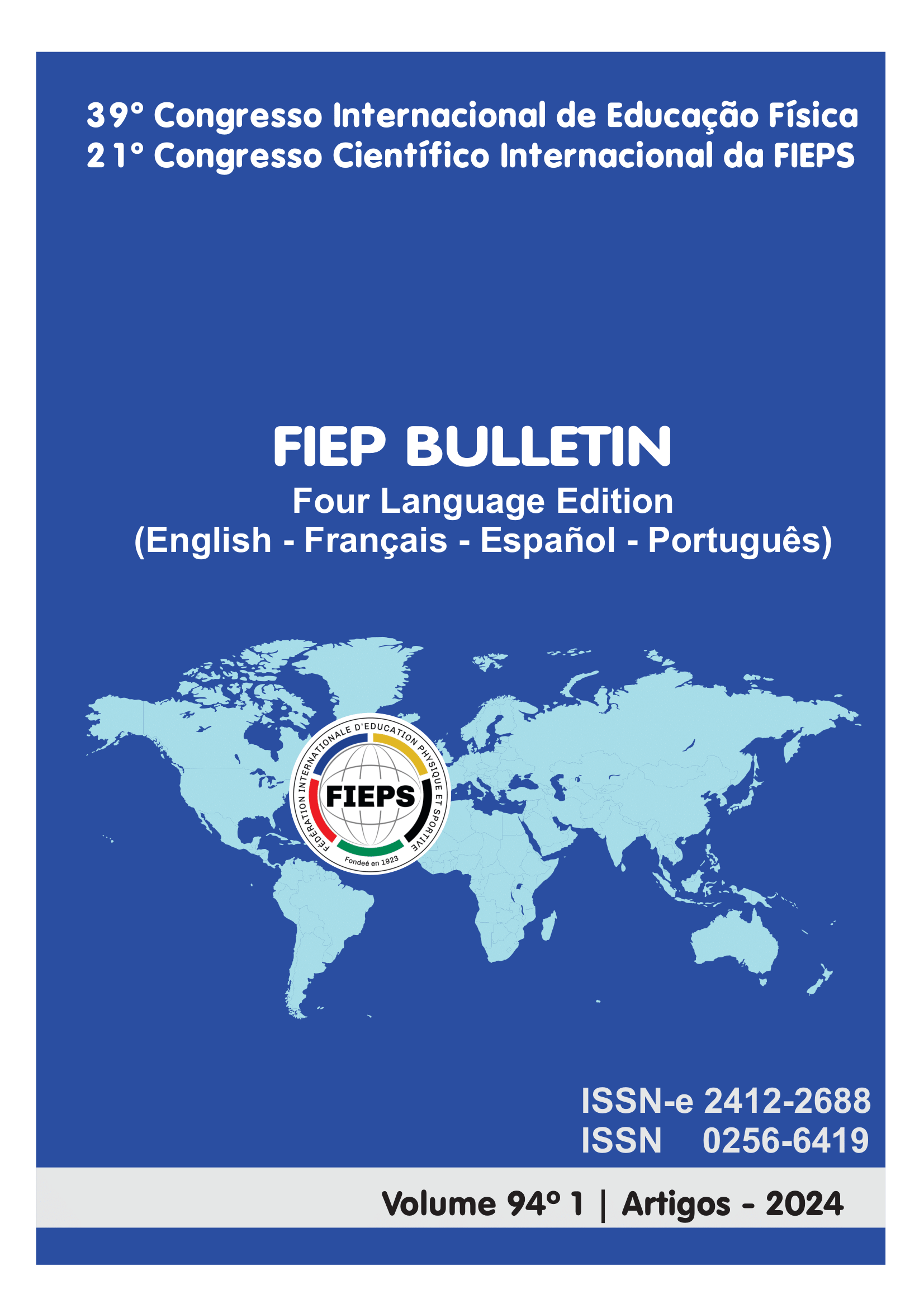BASES FISIOLÓGICAS DO TREINAMENTO PARA ATLETAS DE MEIO FUNDO E FUNDO DO ATLETISMO: UMA BASE PARA A PRESCRIÇÃO DO TREINAMENTO DE ATLETAS DE ORIENTAÇÃO SPRINT
DOI:
https://doi.org/10.16887/fiepbulletin.v94i1.6795Resumo
A modalidade sprint do esporte orientação é um evento de média duração (12-15min) com picos de intensidade e consequentemente variações da demanda metabólica. A habilidade em recrutar de maneira específica a ação muscular sem redução no desempenho é determinante do resultado final do atleta. A metodologia do treinamento empregada nessa modalidade deve considerar o metabolismo anaeróbio, mesmo que com menor participação durante todo evento, como importante fator limitante do desempenho. A partir dessa observação, o presente estudo teve o objetivo de avaliar a necessidade de utilização de formas de treinamento de provas de meio fundo e fundo como base para atletas desta modalidade sprint. A literatura disponível fornece importantes informações com base em eventos de média e longa distância, porém há uma importante lacuna acerca de provas de sprint. A pesar disso, as informações disponíveis contribuíram para demonstrar que o metabolismo anaeróbio é importante fator determinante do desempenho. Concluiu-se então que o programa de treinamento da temporada esportiva deve contemplar aspectos do treinamento anaeróbio com objetivo de aprimorar o desempenho em provas de orientação sprint minimizando os efeitos do aumento do lactato sanguíneo devido aos picos de intensidade e variação na velocidade de corrida durante a prova.
Downloads
Referências
Almeida, R. A. C. d. S. d. (2011). "Análise preliminar da influência anaeróbia no desempenho de atletas de orientação." Fiep Bulletin - online 80(0).
Batista, M. M., A. C. Paludo, D. A. S. MP, M. V. Martins, P. H. Pauli, G. Dal'maz, J. M. Stefanello and M. P. Tartaruga (2021). "Effect of mental fatigue on performance, perceptual and physiological responses in orienteering athletes." J Sports Med Phys Fitness 61(5): 673-679. DOI: https://doi.org/10.23736/S0022-4707.21.11334-9
Billat, L. V. (2001). "Interval training for performance: a scientific and empirical practice. Special recommendations for middle- and long-distance running. Part I: aerobic interval training." Sports Med 31(1): 13-31. DOI: https://doi.org/10.2165/00007256-200131010-00002
Billat, L. V. (2001). "Interval training for performance: a scientific and empirical practice. Special recommendations for middle- and long-distance running. Part II: anaerobic interval training." Sports Med 31(2): 75-90. DOI: https://doi.org/10.2165/00007256-200131020-00001
Billat, L. V. and J. P. Koralsztein (1996). "Significance of the velocity at VO2max and time to exhaustion at this velocity." Sports Med 22(2): 90-108. DOI: https://doi.org/10.2165/00007256-199622020-00004
Bird, S. R., R. Bailey and J. Lewis (1993). "Heart rates during competitive orienteering." Br J Sports Med 27(1): 53-57. DOI: https://doi.org/10.1136/bjsm.27.1.53
Creagh, U. and T. Reilly (1997). "Physiological and biomechanical aspects of orienteering." Sports Med 24(6): 409-418. DOI: https://doi.org/10.2165/00007256-199724060-00005
Hébert-Losier, K., K. Jensen and H. C. Holmberg (2014). "Jumping and hopping in elite and amateur orienteering athletes and correlations to sprinting and running." Int J Sports Physiol Perform 9(6): 993-999.
Hébert-Losier, K., K. Jensen and H. C. Holmberg (2014). "Jumping and hopping in elite and amateur orienteering athletes and correlations to sprinting and running." Int J Sports Physiol Perform 9(6): 993-999. DOI: https://doi.org/10.1123/ijspp.2013-0486
Hébert-Losier, K., S. Platt and W. G. Hopkins (2015). "Sources of Variability in Performance Times at the World Orienteering Championships." Med Sci Sports Exerc 47(7): 1523-1530. DOI: https://doi.org/10.1249/MSS.0000000000000558
Johansson, C., L. Tsai, E. Hultman, R. Tegelman and A. Pousette (1990). "Restoration of anabolic deficit and muscle glycogen consumption in competitive orienteering." Int J Sports Med 11(3): 204-207. DOI: https://doi.org/10.1055/s-2007-1024792
Larsson, P., L. Burlin, E. Jakobsson and K. Henriksson-Larsén (2002). "Analysis of performance in orienteering with treadmill tests and physiological field tests using a differential global positioning system." J Sports Sci 20(7): 529-535. DOI: https://doi.org/10.1080/026404102760000035
Smekal, G., S. P. Von Duvillard, R. Pokan, K. Lang, R. Baron, H. Tschan, P. Hofmann and N. Bachl (2003). "Respiratory gas exchange and lactate measures during competitive orienteering." Med Sci Sports Exerc 35(4): 682-689. DOI: https://doi.org/10.1249/01.MSS.0000058358.14293.DE
Tønnessen, E., I. S. Svendsen, B. R. Rønnestad, J. Hisdal, T. A. Haugen and S. Seiler (2015). "The annual training periodization of 8 world champions in orienteering." Int J Sports Physiol Perform 10(1): 29-38. DOI: https://doi.org/10.1123/ijspp.2014-0005
Wakefield, B. R. and M. Glaister (2009). "Influence of work-interval intensity and duration on time spent at a high percentage of VO2max during intermittent supramaximal exercise." J Strength Cond Res 23(9): 2548-2554. DOI: https://doi.org/10.1519/JSC.0b013e3181bc19b1
Downloads
Publicado
Como Citar
Edição
Seção
Licença
Autores que publicam nesta revista concordam com os seguintes termos:- Autores mantém os direitos autorais e concedem à revista o direito de primeira publicação, com o trabalho simultaneamente licenciado sob a Licença Creative Commons Attribution que permite o compartilhamento do trabalho com reconhecimento da autoria e publicação inicial nesta revista.
- Autores têm autorização para assumir contratos adicionais separadamente, para distribuição não-exclusiva da versão do trabalho publicada nesta revista (ex.: publicar em repositório institucional ou como capítulo de livro), com reconhecimento de autoria e publicação inicial nesta revista.
- Autores têm permissão e são estimulados a publicar e distribuir seu trabalho online (ex.: em repositórios institucionais ou na sua página pessoal) a qualquer ponto antes ou durante o processo editorial, já que isso pode gerar alterações produtivas, bem como aumentar o impacto e a citação do trabalho publicado (Veja O Efeito do Acesso Livre).









